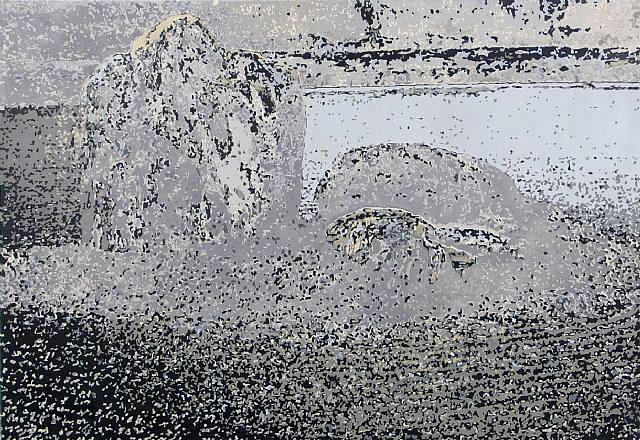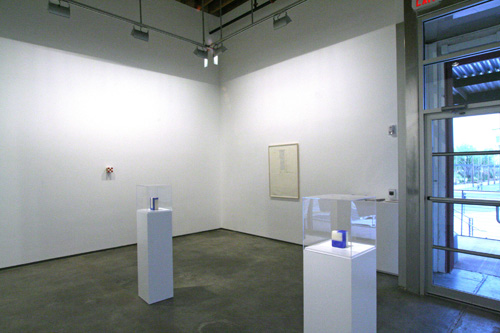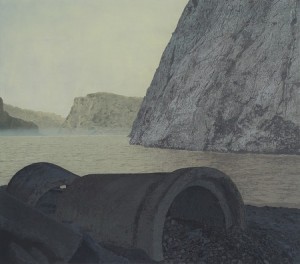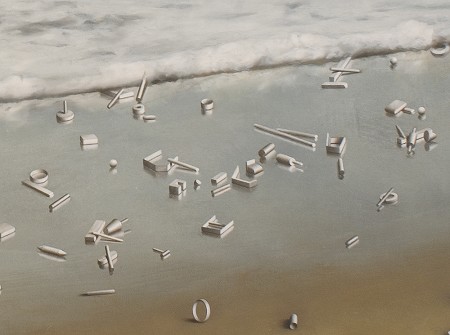
Art in Review: Santa Fe Contemporary
While spring in Santa Fe can toss rogue winds that seem to fool with your equilibrium, as they did the evening of April 30th when I went out to see these shows, there was something very stilling about getting down with the Stuart Arends show at James Kelly Contemporary. Arends is an artist who lives in the plains country of New Mexico and, judging by what appears in this small retrospective, has been restlessly experimental while never really letting things get out of hand.

Stuart Arends "P.D.F #3" 2009 oil paint & beeswax
Arends created a box that has a slippery yellow bronzey surface, as if in pasting paper to an armature he didnt want to lose that sense of the excitement of delivery, a bauble. In the newest work resembling at first pillar candles, Arends is molding sculpture that is his riff on Piero della Francesca. Pause for a moment and think of those columnar compositions of Pieros.
The color blue – I know this about Raphael – was often used for the virgins hem. In the 15th century the most precious ultramarine blue came from lapis. So precious too was the mixing of blu cerulean that its grit probably got re-mixed for other paint needs. Cerulean, is a word I have always adored and which is often hitched to Yves Klein blue. Blue is light sensitive, subject to fading. In the 15th century the most precious ultramarine blue came from lapis. Piero died, they think, around 1492 so his paintings must be viewed in light of the inevitable fading of the color over these 518 years.
I very much like the objet de vertu feeling of the Arends pillar sculpture. It also made me briefly reflect that objecthood as construed by Jim Kelly who over these years keeps exhibiting makers of small sculpture in the West – including Ken Price, Marc Basemans intense tiny drawings, the gestural marks of Wes Mills – enjoys an intervention between the intimate physical space in which art sidles up to you but also holds you off.

Stuart Arends installation: In the inside gallery at James Kelly, a tall and angular drawing hangs on a wall that abuts the tiniest pinkest piece diagonal to one of the sculptures.
On April 30th I briefly stopped in on Vanishing Points at LewAllen projects. As cogently explained by Alex Ross, the show deals in paint strokes as data. The abstract garden of Ry oanji by Steve Robinson calls to mind Terry Winters even as Gerhard Richter is inevitable. To make a good painting is an interesting question for good paintings can be very satisfying although more than ever raise the what are you looking at? (hey, you) problem.

Saul Becker "Cornucopia", 2009. Oil On Linen On Panel 39 in x 44 in
The installation space for this show is too cramped. Better as a method of seeing these new paintings would be to come upon them one by one under a lower ceiling on a long skinny wall. Think Mies. The information of teeming paintings is a controlled chaos rendered form. Still, in looking at some of these works which make you want to get closer, closer, the referents are really inescapable. A hillside falling off itself. Rough trade crawling up rope ladders onto mud roads. The infernal ripping apart of things to expose their gory ecstasies.
The BP oil spill had not yet begun or I did not know about it yet in seeing Saul Beckers spilling shale. I think Bill Mahers been talking about that, black feet on beaches kind of deal. To the extent that there is a shadowy note of near-menace in Becker, it is also timely that his work reveals too the odiousness of our times and the question of painterly landscape. Maybe we should paint the landfills with the captured oil. Wipe it all down with paper we make from pulp packaging then freeze it and when the day comes that we orbit we can pop it skywards.

Detail of Marti Cormand's "Deposit", 2010 Oil On Canvas 42 in x 52 in
Finally the painter Marti Cormand enters the mix as a note of pure artifice as the sea extrudes so many pins and jacks and dislodged cogs. See image above for detail of the foreground in his painting “Deposit”. The paint is like seal skin and indeed the color intoxicating.
All three painters are involved with data and the question of why paint. It is a good question. Many are good paintings. But it needed a different architecture. It also needs discussion about what perspective on perspective can be summed up as the transition from seeing with one eyes level at the point that vanishes to a sense of being totally scale-overwhelmed by everything. In a sense I think some of these paintings need to get a little smaller for a while.
(top photo: Steve Robinson “Ryoan-Ji 16”, 2008)
